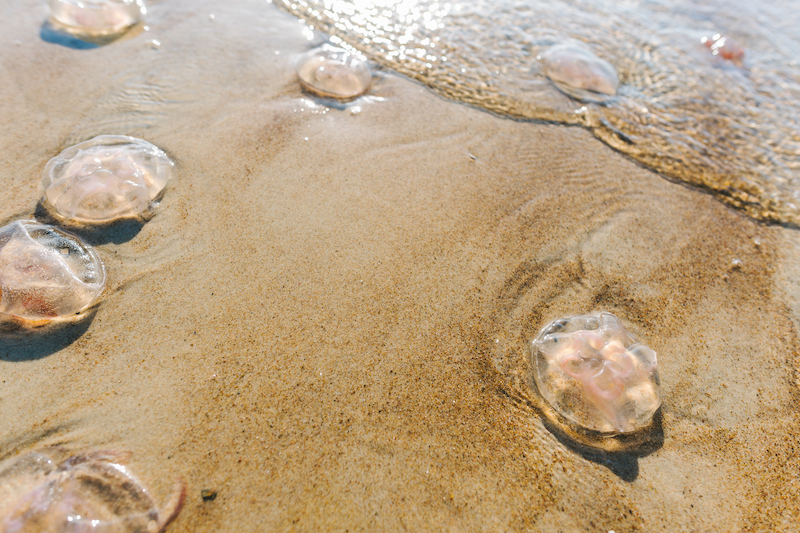


What’s with all the jellyfish?
Photos by iStock and courtesy of Bryan Garcia and Jackson Donnelly August 05, 2025
UD experts explain the summer sting
Like swimming through hair.
This is how competitors described a lifeguard competition held in Rehoboth Beach in July, when Delaware’s jellyfish invasion kicked into high gear.
“Every stroke we take, we get a handful of these guys,” said Bryan Garcia, an organizational leadership major at UD (Class of 2026) and a member of the Rehoboth Beach Patrol since 2022. “Some of their tentacles are three feet long and they literally sting you from head to toe. It’s pretty absurd.”

Or, as 2025 graduate Jackson Donnelly, a member of the Bethany Beach Patrol for seven seasons, put it: “This is the worst I’ve seen. On a recent Saturday, my partner and I kept a tally of all the people who approached us about stings: 26.”
No, this isn’t the plot of a briny horror film — for First State beachgoers, it’s the (pulsating, gelatinous) reality. Brainless, boneless and heartless in more ways than one, the jellies have landed.
So what’s going on? And how long will it take for this particular sting operation to float away? Blue Hens offer five things to know about the tentacled blobs.
1. Know thy enemy
Think of these prehistoric invertebrates as living water — jellyfish are made up of more than 94% H₂O. They aren’t technically fish but, rather, plankton. And they don’t swim in the traditional sense; they drift with ocean currents. While over 2,000 species have been identified worldwide, Delawareans typically encounter just a handful. These include the non-stinging, walnut-shaped comb jelly and the saucer-like moon jelly (you may have seen children handling the latter with their bare hands). Then there are the true baddies: Atlantic sea nettles (dome-shaped bells with trailing tentacles) and lion’s mane jellies (fiery-orange bodies with dense, cascading tentacles). Both deliver painful stings — they come lined with barbed, venomous harpoons used to paralyze prey and ward off predators … or unsuspecting boogie boarders.

2. A perfect storm
Jellyfish blooms are cyclical, and if conditions are right, an explosion can occur. When warm water meets the right current, wind direction and salinity level, it’s a jellyfish world, and we’re all just swimming in it. But don’t fret — as quickly as they come, they can drift away. A cold snap or upwelling could have them on their way tomorrow.
3. The bigger picture
Climate change has likely supercharged the global jellyfish population. (There are so many pulsating around the world, the animals have been known to capsize fishing boats and clog intake pipes at nuclear power plants.) “Anytime you have warmer water — and trends are showing warmer water — you’ll see potentially higher numbers,” said Christopher Petrone, Delaware Sea Grant advisory service director. But whether a changing climate is a factor in Delaware’s current bloom? “Incredibly difficult to say,” Petrone added. “So many factors contribute to population dynamics.”
4. Treat it right
When it comes to handling a sting — which can burn and then itch — misinformation is rampant. (No matter what you learned from the sitcom Friends, don’t pee on yourself; it might exacerbate the pain.). Dr. Kelly Frick, medical director of Student Health Services at UD, recommends being proactive — wear a rashguard or wetsuit in the water. And, if tentacles still get you, remove any remaining barbs with tweezers, rinse for 30 seconds with vinegar (or, if not available, seawater) and then soak the affected area in hot water for 20 to 40 minutes, until the pain resolves. While allergic reactions are rare, they can happen. If you experience dizziness, trouble breathing, an abnormal heart rate, nausea/vomiting or headache, seek medical attention immediately.
5. It’s not all bad
Sure, they might put a damper on a beach day, but jellyfish serve a purpose — they’re food for the charismatic and universally beloved sea turtle as well as the awe-inspiring sunfish, a gentle visitor to the Delaware Bay that grows as big as a small car. Plus, they’re pretty magnificent in their own right. “Jellyfish are really amazing, beautiful creatures,” said Jonathan Cohen, professor of marine science. (He points specifically to the non-stinging comb jellies that can be rainbow-patterned by day and glow bioluminescent blue by night.) “They’re part of nature, and they’re fun to see. So be sure to really notice them — just do it carefully.”
Contact Us
Have a UDaily story idea?
Contact us at ocm@udel.edu
Members of the press
Contact us at mediarelations@udel.edu or visit the Media Relations website

